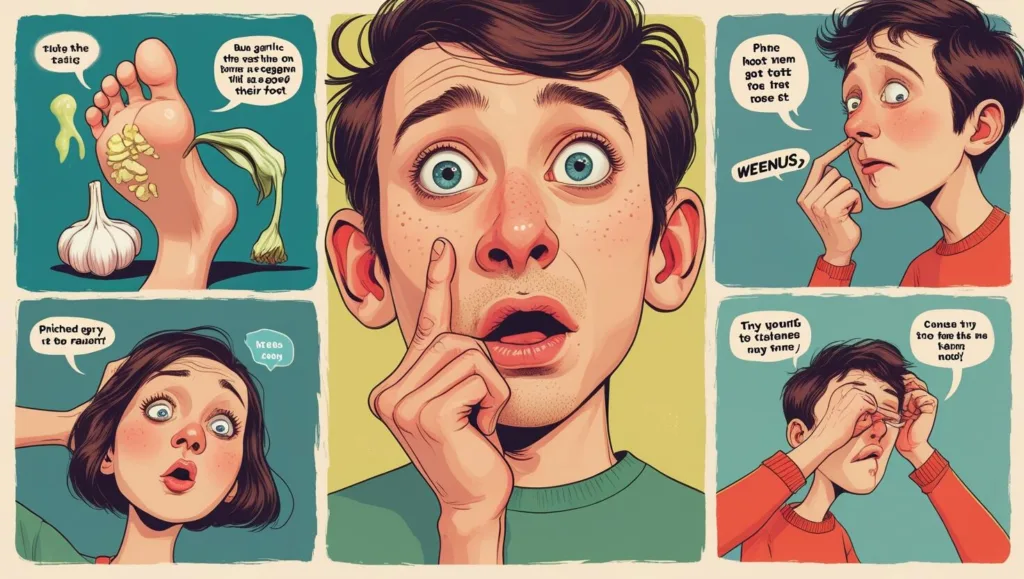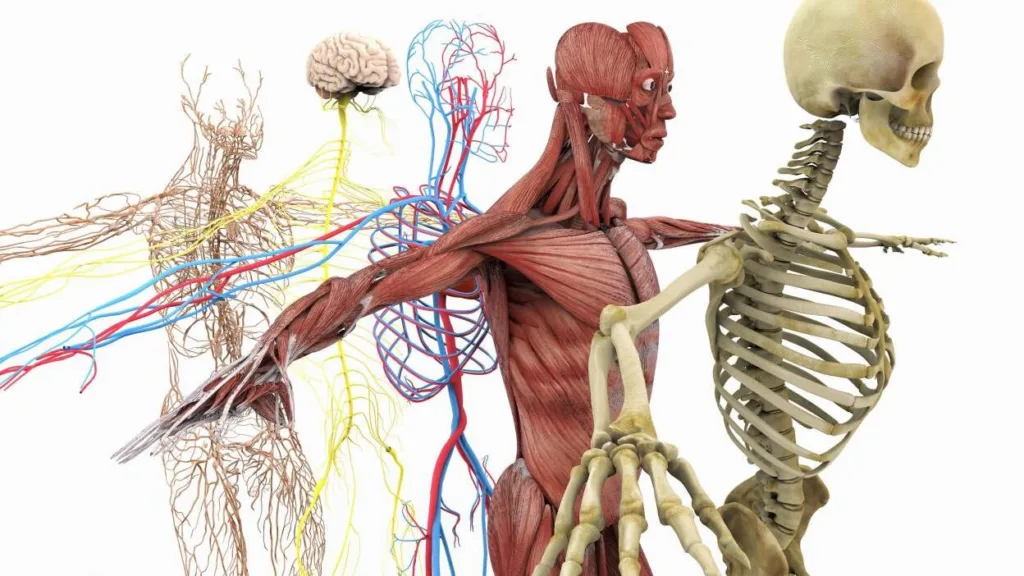Contents
Fun Facts About the Human Body

1. The human brain can hold more than 2.5 million petabytes of information, which is equivalent to 2,500,500 gigabytes.
2. Bruce Lee moved so quickly that film editors slowed down the footage to make his movements visible.
3. Your weight is slightly less when the moon is overhead.
4. Although you may call the whole thing your “ear”, the visible part is actually called the auricle and it’s made up of many different parts.
5. Sneezing sounds aren’t the same everywhere; they depend on culture. While Americans might sneeze with an “ah-choo!”, Filipinos might opt for “ha-ching!”. Those born deaf only include sounds from moving air when depicting a sneeze, excluding additional sounds.
6. Your parents may have teased you about having “selective hearing” if you didn’t hear them calling, but selective hearing, also known as “selective auditory attention,” is a genuine phenomenon where we concentrate on one sound while ignoring others.
7. Every two weeks, the tongue’s 10,000 taste buds are replaced. While our love of food is clear, the secret to its deliciousness lies in our taste buds, the tiny sensory organs on our tongues. The aging process impacts our taste buds, resulting in fewer taste buds over time. Older adults might possess around 5,000 working taste buds, affecting how they experience flavours and complicating the study of food enjoyment.
8. We perceive the world upside down. The light reflecting off objects is what allows us to see them. The light is bent by the curved front of our eyes, creating an inverted image on the retina at first. Our brains magically reorient images, so we see the world correctly.
9. Research shows average beard length can reach 3 feet if untrimmed. Genetics plays a large role in how much facial hair you grow. Beard growth is also affected by factors such as race and age. Most men see peak beard growth between ages 25 and 35.
10. We find our voice recordings to be unpleasantly higher-pitched and slower than normal. Many people share your discomfort when hearing their recorded voice. It can be explained scientifically through physiology and psychology. When you hear your voice, sound waves travel and reflect into your ear; recordings miss this natural resonance. Consequently, you may find your recorded voice sounds strange. The discrepancy between your perceived voice and recordings stems from how sound interacts with your ears.
11. You can’t hum and hold your nose simultaneously. Experience this intriguing phenomenon for yourself; give it a try. Try humming with your nose pinched; you’ll find it can’t be done. This unusual result is explained by the nature of humming; With both your mouth and nose sealed, there’s no pathway for air to escape. Consequently, you will be unable to make any sound with your vocal cords.
12. You also blush internally. The rosy glow on your cheeks and the warmth in your stomach are both caused by increased blood flow. This phenomenon makes your face redden in response to emotions or circumstances. At the same time, your stomach lining undergoes a parallel transformation, flushing red with blood, illustrating the intriguing relationship between emotional and physical reactions.
13. The hitchhiker’s thumb is known for its unique 90-degree backward bend, a trait that gives it its name. Though this thumb is hypermobile, it works surprisingly well and causes no pain. Intriguingly, the condition is painless, hereditary, and linked to a recessive trait. This highlights the captivating interaction of genes, resulting in a distinct physical trait that enhances, rather than hinders, the genetic diversity.
14. Fingernails grow faster than toenails. The increased blood flow to your hands, being closer to your heart, is the reason. Compared to toenails, fingernails are longer. Because they’re close to the heart, nails grow slower in cold weather due to the reduced blood flow. Blood flow, distance from the heart, and external factors explain why fingernails and toenails grow at different rates.
15. You can learn to raise one eyebrow. Usually, between 30 and 40 percent of people can raise one eyebrow, and about 24 percent are born with this skill. Training can help you master this skill. Practice allows anyone to master raising a single eyebrow, thus growing the group of people capable of this captivating and often amusing expression.
fun facts about the human body, weird facts about the human body, 50 amazing facts about human body
Weird Facts About the Human Body

1. You can lick someone’s elbow without them feeling it if they’re distracted.
2. Every two weeks, your stomach must create a new mucus layer, or it will digest its own tissue.
3. Young coconut liquid serves as a blood plasma substitute.
4. Distorted or abnormal human figures and faces unsettle humans and other primates. This fear response is particularly noticeable when they see images with big, round eyes, exposed teeth, or unusual facial expressions. When something seems almost human but isn’t quite, that unsettling feeling is known as the uncanny valley effect. While stylized human cartoons are cute, hyperrealistic ones can be unsettling instead of relatable. Avoiding severely disfigured people could have helped prevent contracting serious diseases like syphilis, leprosy, and smallpox, as they cause significant disfigurement. Avoiding people with diseases or disfigurements reduced the risk of catching deadly illnesses, a key survival strategy.
5. Scientists previously believed that yawning served to increase oxygen intake and boost the body’s oxygen supply. A new theory proposes that yawning cools the brain, increasing alertness.
6. Soaking for a long time makes fingers and toes wrinkle. The initial hypothesis was that this condition developed due to fluid shifts in the body when submerged in water. But, experts now think this response could enhance grip when wet.
7. Just as someone is about to fall asleep, they may suddenly feel like they’re falling. They are then jolted awake by a sudden movement of the body. While the precise cause of hypnic jerks remains unclear, a prevalent theory attributes them to the nervous system’s natural deceleration, leading to involuntary muscle twitches.
8. Hiccups resemble a chain reaction within the body. Initially, the diaphragm contracts suddenly and involuntarily. That closes the vocal cords, thus producing the characteristic “hic” sound from the throat. Although hiccups may sometimes indicate an underlying medical condition, they usually stem from consuming too much food, experiencing excitement, or drinking excessive carbonated drinks.
9. Goosebumps are a physical reaction to cold temperatures or intense feelings, including shock and awe. Tiny muscles at the base of the body’s hair follicles contract, causing the hair to stand on end, resulting in this reaction. Perhaps this automatic response is nature’s method of making animals seem larger and more frightening during danger.
10. Even with a hard pinch, your elbow skin remains insensitive to pain. The skin on your elbow, the “Weenus,” has few nerve endings, making it surprisingly insensitive to pain. Because it has fewer pain receptors, olecranal skin (the skin on your elbow) reacts less to pressure than other areas of your body. This unique trait highlights the complexity of our senses, showing that sensitivity varies across skin areas even with identical stimuli.
11. Your feet can taste garlic. Placing your foot in a bag filled with garlic cloves and rubbing them on the underside can evoke a garlic taste. Secret taste buds don’t cause the intriguing phenomenon on your feet; instead, garlic’s aromatic molecules (especially allicin) permeate your skin, enter your bloodstream, and reach your mouth, allowing you to taste the garlic despite its unusual journey.
12. Our noses and ears don’t actually grow bigger as we age; it only seems that way. Instead, blame gravity and the loss of skin elasticity for this illusion. The effects of aging, specifically collagen and elastin loss, make these body parts more visible over time. Although the skeletal structure remains unchanged, the sagging soft tissue creates the illusion of continued growth.
13. It’s impossible to tickle oneself. Amazingly, our brains predict our movements, always a step ahead. Tickling yourself doesn’t work because your cerebellum alerts your brain that the touch is self-generated. This “tickling immunity” shows how our brains tell the difference between sensations we expect and those that surprise us.
fun facts about the human body, weird facts about the human body, 50 amazing facts about human body,
Science & Medical Facts About the Human Body

1. The tongue is the strongest muscle in the body.
2. Research on how perceived value affects medical results showed that patients given a $1500 placebo pill responded better than those given a $100 placebo pill.
3. Chewing gum, mints, or vomiting won’t fool a breathalyzer; alcohol’s in your blood, not your stomach, and your lungs exhale its vapour.
4. Mammalian hair follicles have tiny arrector pili muscles that cause goosebumps by pulling on the follicle, raising the hair, and creating a bump on the skin.
5. A doctor strikes a patient’s knee with a small rubber hammer, causing their leg to jerk upward. It’s known as a knee-jerk reflex. Hammer taps stretch the patellar tendon, triggering a spinal cord response that contracts the thigh muscle. Reflexes are crucial for maintaining balance.
6. Your immune system is unaware of your eyes. Eye injuries or infections can trigger an immune response that mistakenly attacks your eyes, potentially causing blindness.
7. Dehydration or mineral deficiencies (calcium, potassium) during exercise can cause intense leg cramps, often called charley horses. These situations may irritate nerves linked to muscles, resulting in spasms.
8. Our bodies fully regenerate, except for our teeth. While our bodies are amazing at self-repair, our teeth have limitations. Teeth, unlike skin and bones, are unable to repair themselves naturally. The enamel’s lack of living cells is the reason for this limitation, as it’s a tough protective layer. Modern dentistry offers fillings, crowns, and implants to replace teeth that can’t heal naturally. Although teeth cannot naturally regenerate, dentists can work miracles.
9. The marks above the sacroiliac joints, noticed by Michelangelo, were dubbed “dimples of Venus” (women) and “dimples of Apollo” (men) by the artist. These unique back dimples, like charming chin or smile dimples, are a genetic wonder. Though more prevalent in women, these cute-back dimples affect only 3–8% of people regardless of gender.
10. There’s a 99.9% genetic similarity among all humans. Although we value our unique qualities, our genetic makeup reveals surprising commonalities. Genetically speaking, humans are astonishingly alike, sharing 99.9% similarity. The differences between the two individuals are found within the remaining 0.1%. We have more in common than we realize. It’s remarkable to consider that our individuality is determined by such a small part of our genes.
11. Tongue prints could replace fingerprints. Just like fingerprints, each person’s tongue has unique markers. Differences in shape and surface texture lead to individuality. Ongoing research indicates tongue prints, with their unique geometric and textural qualities, may be useful for identification. Tongue prints, being unique, could be used for biometric identification, highlighting how technology uses human anatomy for security.
12. Thumb sucking can lead to serious dental issues down the line. Although babies lose their sucking reflex around 6 months, many continue thumb-sucking for comfort. While thumb-sucking offers temporary comfort to a child, it risks causing significant orthodontic issues in the future. Conditions such as an anterior open bite, characterized by non-meeting front teeth despite closed back teeth, and an underdeveloped or malformed lower jaw can occur. Early intervention is crucial for preventing future orthodontic problems.
13. Teeth that are too small for your jaw can cause gaps between teeth. Tooth gaps, medically termed diastema, are common, especially between the front teeth. Largely determined by genes, it tends to be hereditary. Although more common in children, just 20 percent of adults retain this gap, leading to varied views on its attractiveness. Gaps in teeth, real or not, frequently result from lost baby teeth, which naturally close later. Adult dental intervention might be needed if the issue continues. Contributing factors are genetics, poorly functioning chewing teeth, nail-biting, and teeth of uneven size.
about the human body
Historical & Cultural Facts About the Human Body
1. Dating back to the 3rd-5th century AD, the oldest known socks were designed for sandal wear, featuring a split toe.
2. Military marksmen and other gunners use a fascinating type of eyeglasses. Typically made of plain glass, these lenses lack correction, their outer edges blurred by a grinding stone. Only a small inner circle remains clear. The marksman, in effect, filters out distractions to focus exclusively and accurately on the target. To reduce intense sunlight, glass is frequently tinted. While orange and amber are popular, blue comes in a close second.
3. Because of the sheer number of processes in the human brain, some neuroscientists consider it the universe’s most complex object. Scientists approximate it contains roughly 86 billion neurons, 85 billion other cells, and 100 trillion connecting synapses.
4. Blue eyes resulted from a genetic mutation. The HERC2 gene mutates, which results in blue eyes. Scientific research shows that people with blue eyes all share a common ancestor who lived between 6,000 and 10,000 years ago, and this ancestor is responsible for the genetic mutation that causes blue eyes. Blue eyes lack blue pigmentation; their blue colour comes from Rayleigh scattering, the same effect that colours the sky blue.
Here you can find 30 Random Facts
Here you can find 50 Weird but True Facts
Ref fun facts about the human body, weird facts about the human body, 50 amazing facts about human body
